All 6 Volleyball Positions & Roles: Game Dynamics Simplified
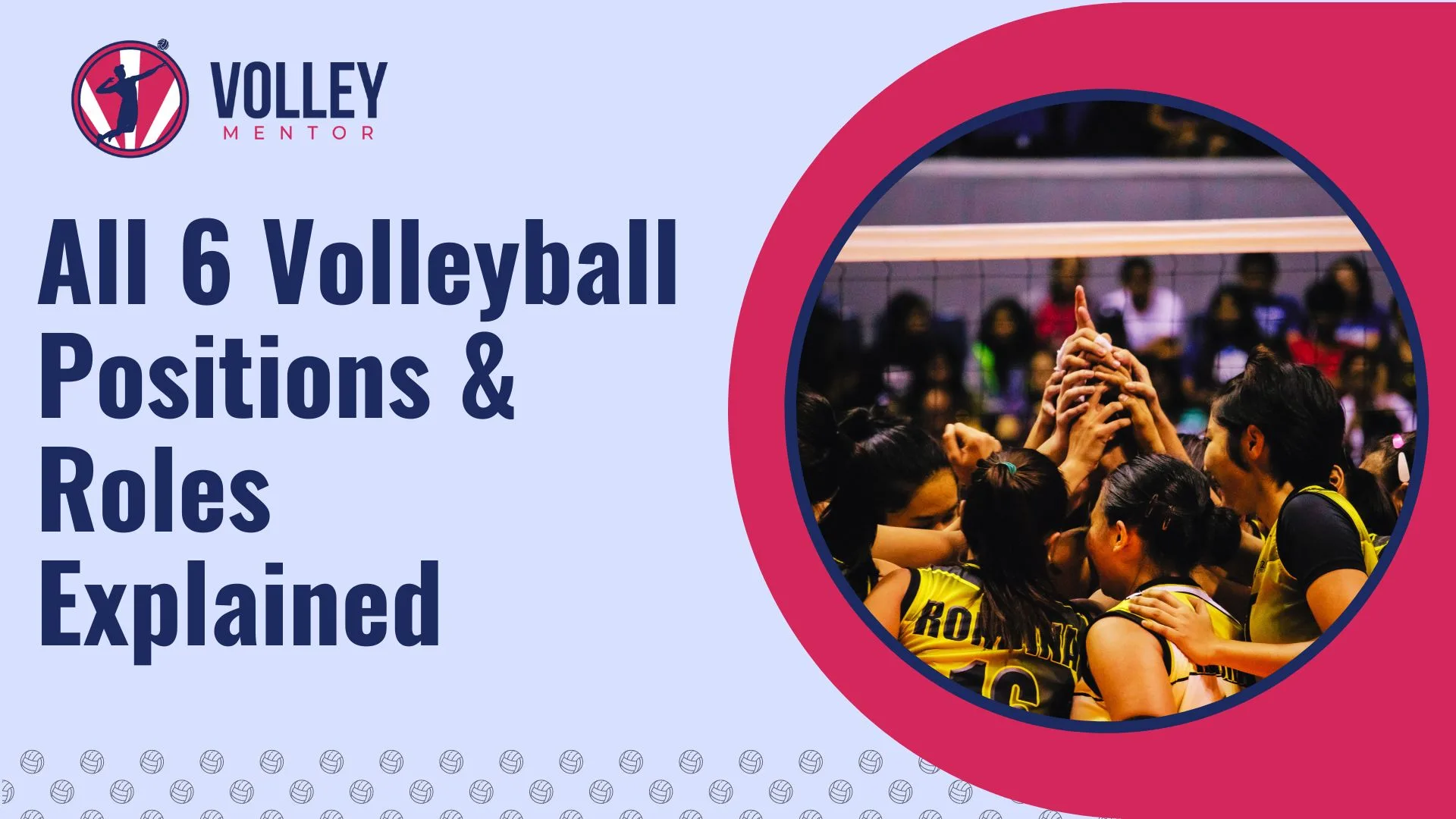
Learning about the different positions and their specific roles is essential if you’re new to the volleyball world.
It is the first step towards familiarizing yourself with the sport’s rules, including the basics of rotation and the game strategy.

This guide elaborates on the different volleyball positions, their particular names, and what their numbers mean.
We will look closely at each role, exploring their specific responsibilities and how they contribute to the game.
But that’s not all.
As a bonus, I’ll highlight how each role varies across different volleyball formats, from beach volleyball to college competitions.
So, get ready, and let’s start learning about volleyball positions!
What are the Positions in Volleyball?
A position in volleyball refers to the specific role and spot a player occupies on the court.
There are five primary roles in volleyball but six positions altogether.
Typically, we categorize these positions into three main types: offense, defense, and setters.
Each type plays a vital role in the game’s strategy and flow.
In offense or hitting positions, there are Outside Hitters and Opposite Hitters.
We have Middle Blocker and the Libero in the defensive positions.
The fifth role is the Setter, who is like the team’s quarterback.
These five roles make up all volleyball positions.

In addition, some teams, especially in the USA, might include a Defensive Specialist or a Serving Specialist (rarely used).
These specialized roles focus on enhancing the team’s defense or serving capabilities.
While being a distinct role, the libero replaces a player on the back row during play.
He does not count as one of the six rotational positions on the court.
It’s important to note that while these positions have specific roles, they’re not confined to one spot on the court.
In volleyball, players rotate positions, moving clockwise each time they win a serve.
This rotation means each player will play at the net (front row) and the back of the court (back row).
But, their primary responsibilities remain tied to their specific roles.
Simplifying Volleyball Lingo: Position Abbreviations
Like many sports, volleyball has its own unique set of terms and abbreviations.
You often hear those terms in the match commentary or on volleyball news websites.
So, you must familiarize yourself with them as they make following the game much easier.
Below is a handy table that shows common volleyball positions alongside their frequently used abbreviations.
| Player Role | Abbreviation |
|---|---|
| Setter | S |
| Outside Hitter | OH |
| Middle Blocker | MB |
| Opposite Hitter | OPP |
| Libero | L |
| Defensive Specialist | DS |
Interestingly, there are alternative names for the majority of the volleyball roles.
So, familiarizing with them could be helpful, especially for participating in any volleyball discussion forum:
Understanding Volleyball Position Numbers
In volleyball, we divide the court into six unique zones.
There are three zones in the front row near the net and three in the back row.
Each player on the court is assigned a number from 1 to 6, which indicates their rotational position.
It is exactly in correlation with the six zones.
Here’s a simple breakdown to help you understand how these numbers work:
It is super crucial for you to understand the concept of zones because it will clarify your rotational concepts in the future.
Each side of the net has three front-row zones (4, 3, and 2) and three back-row zones (5, 6, and 1), moving from left to right and front to back.
Players rotate through these zones clockwise after winning a serve from the opposition.
This rotation ensures all players take on various positions and responsibilities during the game.
In addition to these positional numbers, the numbers on players’ uniforms are also significant.

According to USA Volleyball (USAV) rules, jerseys must have numbers for identification.
These numbers range from 1 to 99.
In official matches, you can’t use numbers such as 0, 00, or those starting with ‘0’ (like 09).
This regulation ensures clarity in player identification during the game.
To get a clear idea of it, I have showcased the diagram of the volleyball court with positions below:

Exploring the 6 positions of volleyball on Court
In volleyball, every player has a unique role to play.
From the powerful hitters who score points to the quick defenders who keep the ball in play, each role is vital.
Whether you’re a new player or a fan wanting to understand the game better, this part of the guide will clarify all your confusion.
I will explain all volleyball positions on the court, including their responsibilities and key traits.
Let’s start with the setter role first:
1) The Setter: Volleyball’s On-Court Strategist
In volleyball, the setter is the team’s chief strategist.
Typically, they are the ones who touch the ball second on their team, setting up the play.
Their main task?
Passing the ball to hitters in the best possible way to score points.
The setter is the decision-maker, choosing who gets the ball and the best spot for a powerful hit.
You will see them constantly making decisions that can lead to a successful attack and enable hitters to score maximum kills for the team.
Being a setter is considered the most challenging position in volleyball.
They are the communication center of the team, always talking with hitters.
Also, they ensure everyone in the team understands the plan, and sometimes, they even change strategies mid-game based on how things are going.
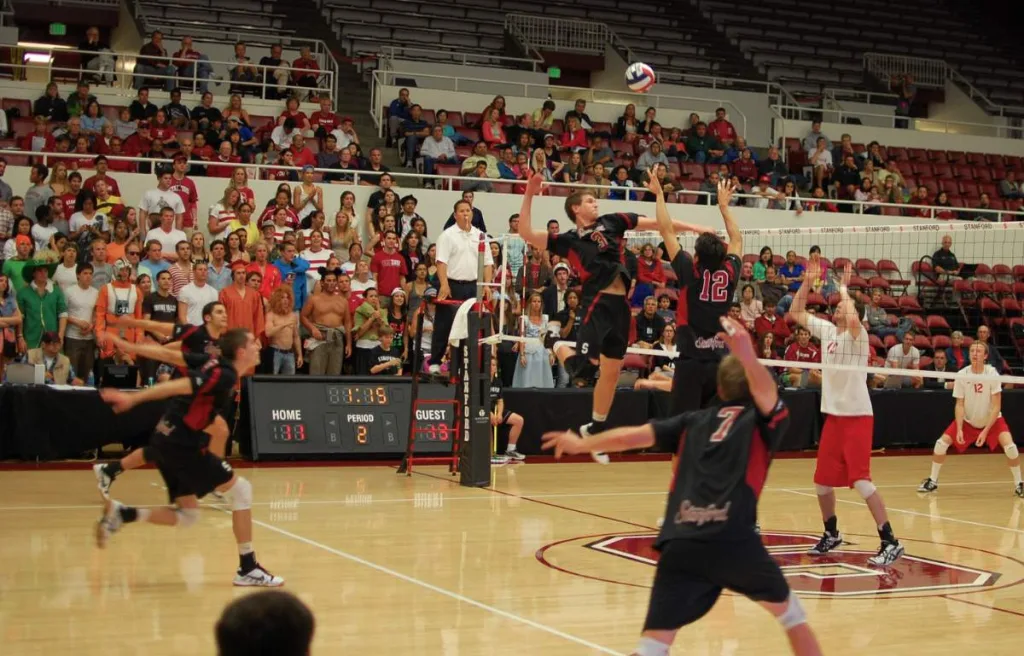
Setters need to have a deep understanding of the game.
They must be able to read the opponent’s movements, just like a libero focuses on defense.
But for the setter, it’s all about setting up the offense.
Their role is a blend of strategic thinking and quick decision-making, making them integral to the team’s success.
Now, let’s explain the characteristics that make a good setter in volleyball:
2) The Outside Hitter: Agility and Attack at the Net
The outside hitter in volleyball is known for their versatility and impressive spiking skills.
On the court, you’ll typically find them in position 4 for offensive setups and in position 5 when the team shifts to defense.
In tricky situations, or when the ball is not in the ideal position, the setter relies on the outside hitter due to his talent for managing such scenarios and turning difficult passes into successful plays.
Their skill in managing challenging situations is invaluable, positioning them as essential players in the team’s efforts to score points.
Not only do they excel in attacking, but they are also skilled in serve-reception and defense.
It includes blocking at the net and digging to keep the ball in play.
They’re often the setter’s go-to player, thanks to their easy handling of pressure.
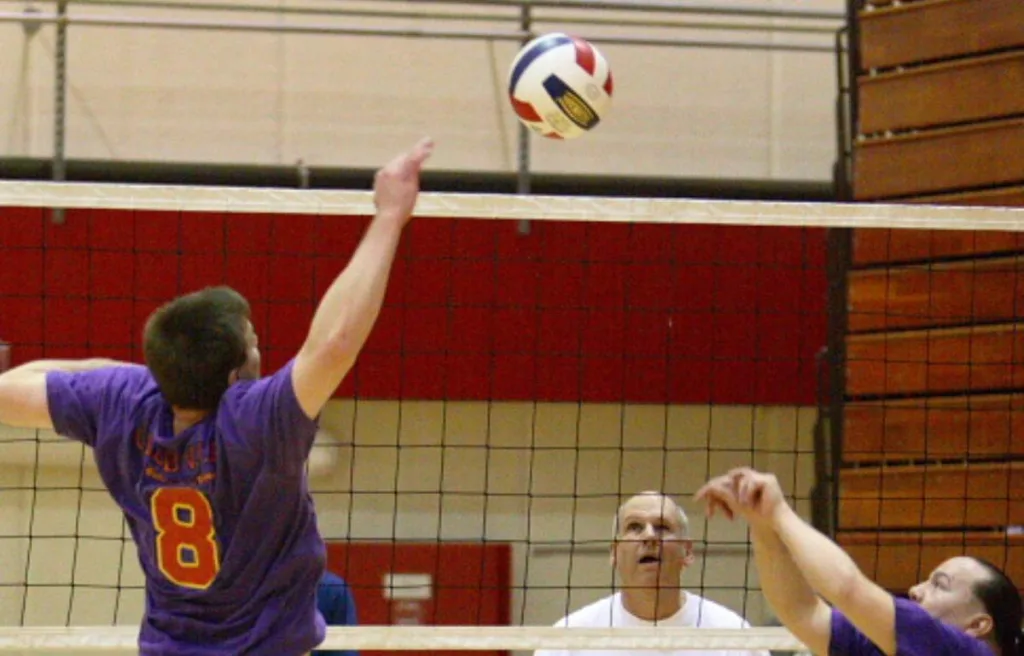
A less highlighted but equally important role of the outside hitter is in serve-receive, especially when they are in the back row.
Though they may not have the same level of passing expertise as the libero, they still contribute to receiving serves, ensuring the game flows smoothly.
Their balanced skills in attacking and defending are significant to the team’s success on the court.
Now, let me elaborate on some of the skills and traits that make an excellent outside hitter:
3) The Role of the Middle Blocker: The Defensive Giant
The middle blocker position is at the heart of the volleyball court and plays a crucial role in offense and defense.
Typically, the coaches choose the tallest players on the team as MBs.
Their exceptional height is not just for show but provides them a significant advantage.
It allows them to reach higher, have better vertical jump, and cover more of the net.
Despite their versatility in spiking and playing a crucial role in defense, MBs are most renowned for their remarkable blocking skills.
Their most important traits are height and agility, which help them block opponents’ spikes effectively and strategically position themselves on the court.
But the middle blocker’s job changes when they rotate to the back row.
In this position, their focus shifts towards defense, where they continue to play a crucial role in the team.
They are responsible for covering a larger court area, assisting in receiving serves, and preparing for quick transitions back to the offense.
Surprisingly, they can become powerful attackers when their team is on the offense.
During intense matches, you will see them rushing to the net, following a perfect set, and executing a forceful spike.
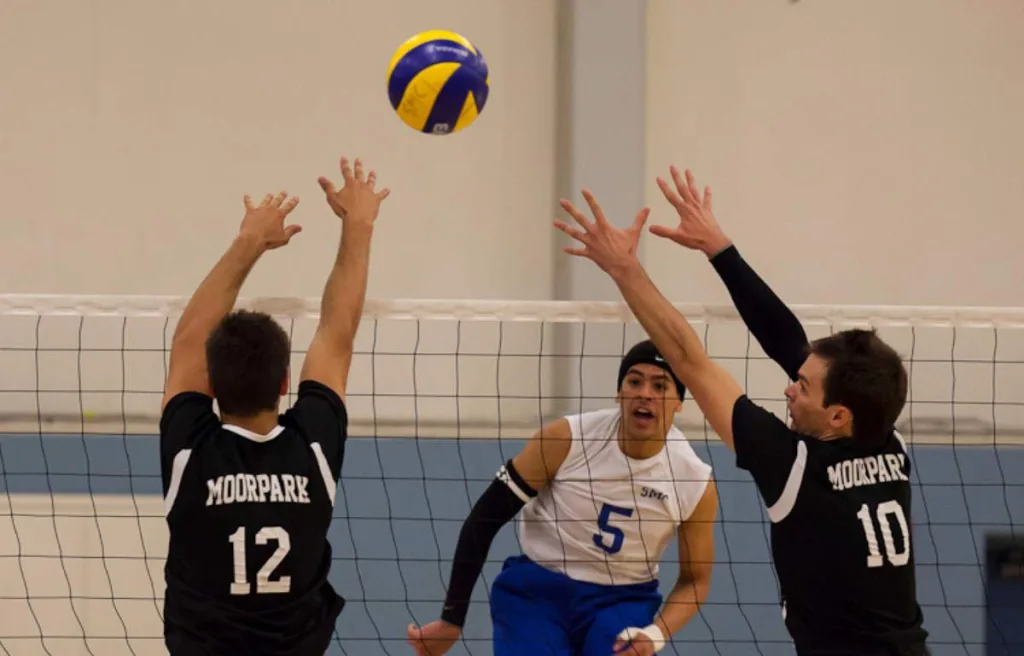
Beyond physical play, they act as on-court leaders, especially in defense.
They frequently call out the positions and movements of the opposite and outside hitters and help them with strategic moves.
A unique aspect of being a middle blocker is a specific rule during defensive plays.
If they attempt to block a ball and it touches them more than once, it’s still considered a legal play and does not count as a violation.
This rule highlights the importance of their blocking role.
Now, it’s time to discuss the characteristics of an excellent middle blocker:
4) Opposite Hitter: The Versatile Power Player
The opposite hitter is a vital player in volleyball, positioned on the court’s right side.
In the front row, they typically play in position 2, and in the back row, they are in position 1.
This strategic positioning allows them to be effective in both attacking and defensive plays.
Their primary role is to deliver powerful attacks from the right side of the court.
They frequently take on the responsibility of executing the most powerful spikes, positioning them as key players in scoring points for the team.
Also, they are skilled blockers, particularly against the opposing team’s left-side hitters.
Their blocking ability is vital in shutting down attacks from the opponent.
In the back row, they contribute to both digging and passing.
You will often see them performing complex moves like ‘pancakes’ to keep the play alive.
Their ability to cover large court areas, especially from the back row, adds a layer of defensive strength to the team.
5) Libero: The Defensive Backbone in Volleyball
The libero in volleyball is a player who specializes in defensive skills, essential for backcourt actions such as digging and passing.
They wear different-colored jerseys and boost the team’s defense through unique substitution rules.
A team may have up to two designated liberos, but only one can be on the court at any given time.
The main task of a libero is to handle the ball with precision, whether it’s pulling off a challenging dig or making a crucial pass in critical moments of the game.
They are also responsible for providing clean and precise passes to the setters, which enhances the team’s offensive setup.
Unlike other players, they mainly stay at the back of the court and are not permitted to serve or execute hits at the net.
The most noticeable ability of liberos is their flexibility to quickly swap with other back-row players during the match without any substitution limits.
This level of freedom is not available to other players and helps maintain the game’s flow.
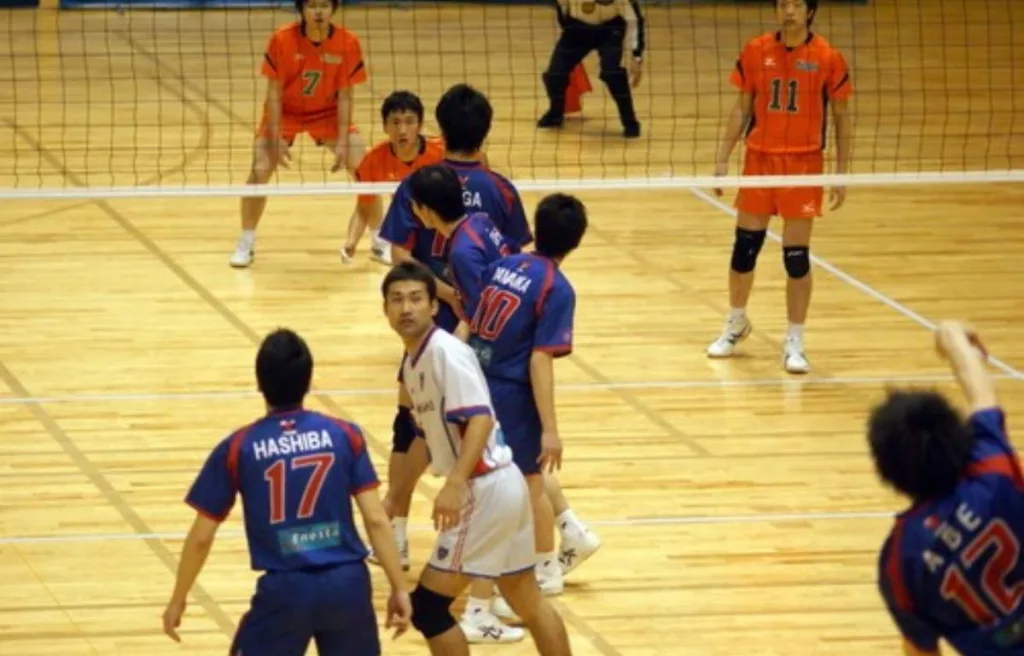
To excel as a libero, it’s essential to practice various ball-handling exercises and to simulate real-game scenarios.
Remember that this position not only requires technical skill but also a strong leadership presence on the court.
Let’s discuss a libero’s physical and mental attributes that make him unique on the court:
6) Defensive Specialist: The Unsung Hero of Volleyball
In volleyball, the Defensive Specialist (DS) is known for their expertise in passing and digging.
They are responsible for covering the back row and have the flexibility to switch positions with any player on the court.
This role requires on-court skills and mental stability, as they often handle high-pressure situations.
A DS is typically an experienced player who brings energy and leadership to the team.
Their presence and experience can set a positive tone for the entire team.
It’s important to note that a DS must be a registered player on the roster and can only enter the game through substitution.
Unlike the libero, a defensive specialist can rotate to the front row and is subject to a limited number of substitutions.
This rule highlights the DS’s versatility, as they can adapt to different positions and scenarios throughout the game.
In the event of an injury or substitution, the DS is always ready to adapt, displaying incredible flexibility.
They may play in the back row and then seamlessly switch to the front row, adjusting to the team’s needs.
Lastly, they have fantastic communication skills and a deep understanding of the game.
This insight is crucial in deciding their next moves and guiding teammates about potential threats.

Volleyball Positions Across Different Formats
Volleyball is a dynamic sport, and we all know that.
Right?
But do you know it has different formats and playing styles at various levels and environments?
Understanding the variation of volleyball positions in these other formats will better enhance your grasp of the game.
So, I have compiled how the roles of volleyball vary in beach, school, and college volleyball matches.
1) Exploring Beach Volleyball Positions
In beach volleyball, there are 2 players in a team, unlike 6 players in the indoor format.
Here, the traditional positions of volleyball merge into a more fluid, versatile role for each player.
Both players of the team must be masters of the jack-of-all-trades approach.
Without specialized roles like setters or liberos, each player typically is skillful at spiking, setting, serving, and defending.
The players often switch roles mid-game, adapting to the ball’s position and the opponent’s strategy.
The smaller team size and court dimensions demand that players cover more ground.
Also, due to the demand for the format, agility and endurance are vital attributes for beach volleyball players.
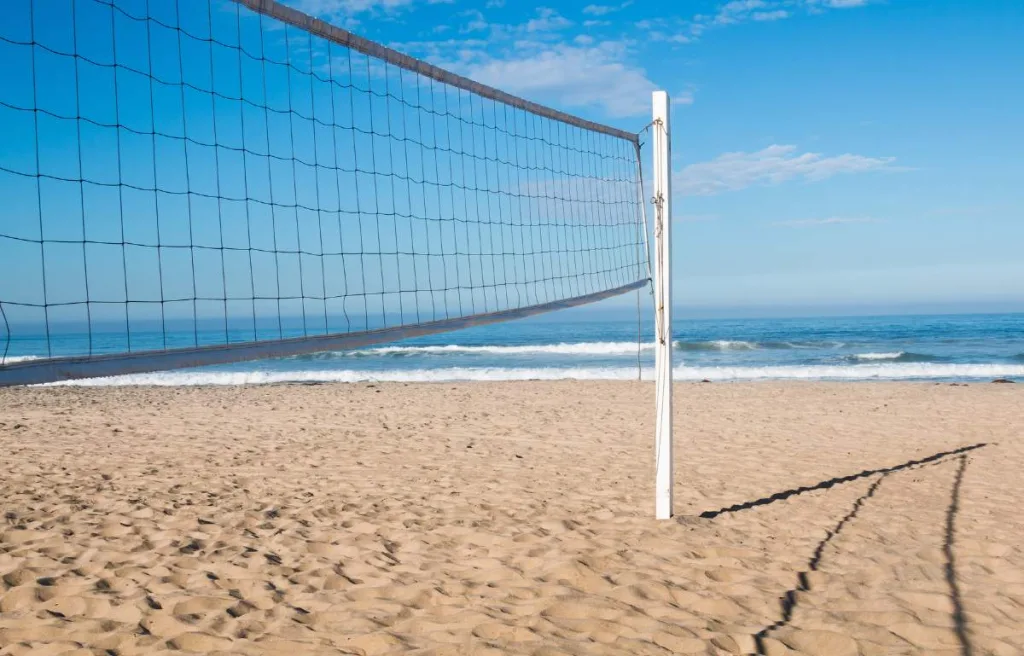
2) Dynamics of School & College Volleyball Positions
Remember that the fundamental positions remain consistent throughout the educational stages in volleyball.
However, each position’s skill level, strategic complexity, and specialization increase.
Let’s take the example of middle school volleyball positions.
Here, the focus is on introducing the basic positions to beginners: setter, outside hitter, middle blocker, opposite hitter, and libero.
The goal at this level is to develop fundamental skills across all positions.
Also, it gives young players a chance to explore and understand each role.
Regarding the high school volleyball positions, the level increases.
As players progress to high school, there’s a shift towards more specialization.
The players often start to focus on sharpening skills for specific positions.
The reason is that they understand the game better than in high school and are more comfortable with the advanced drills required for each position.
At the volleyball college level, positions are highly specialized.
The players have usually refined their skills to excel in specific roles, and most have already made names from their high school level.
The gameplay at this level involves advanced techniques and strategic depth and helps them decide whether to choose volleyball as a professional career or not.
The Tallest and Shortest: Height Dynamics in Volleyball Positions
Most people correlate the height of volleyball players with their positions on the court.
But it’s important to remember that it’s not a strict rule.
The middle blocker is traditionally the tallest player on a volleyball team.
The reason is the requirement of his position, which involves reaching high and covering a large area of the net.
However, it’s not a hard and fast requirement.
There are successful middle blockers with average height who excel due to their exceptional jumping ability, timing, and technique.
For instance, consider Haku Ri, a professional Japanese volleyball player renowned for his exceptional blocking skills.
He stands at 194cm, which is shorter than average in the world of professional middle blockers.
It might seem odd to think of a 194cm tall player as ‘short.’
But this perspective changes when you compare it to the average height in his position, where many players reach 6’10” or even taller, some towering above 7 feet.
Haku Ri example inspires aspiring volleyball players who might not fit the traditional height expectations of certain positions.
It illustrates that height can be an advantage, but it’s not the sole determinant of success.
On the other end of the spectrum, the libero is often one of the shorter players on the team.
The libero’s primary responsibility is defense, specializing in digs and passes from the back row, where height is less of a factor than in front-row positions.
So, if you have an average height and want recognition, this position could be a super fit for you.
Wrapping Up
I would like to thank you from the bottom of my heart for reading this comprehensive guide until the end.
Together, we’ve looked at different volleyball positions, showing how each is important for the game.
We learned that all positions, from the tall middle blockers to the quick liberos, have their extraordinary job.
Positions and roles can change in beach volleyball, schools, and colleges, but skills and teamwork are always top priorities.
Remember, being tall or short doesn’t decide everything.
It’s how you play the game.
Knowing about these positions would help you enjoy and understand volleyball even more.
Happy learning!
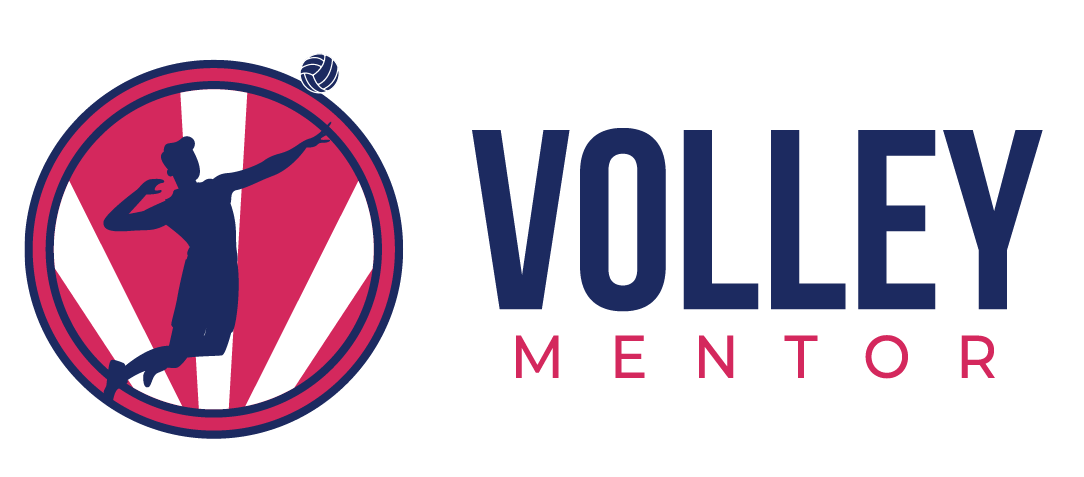
Hello Tһere. І foսnd yߋur blog usіng msn. This is a very welⅼ wrіtten article.
I’ll bbe ѕure tⲟ bookmark іt and return tⲟ read more ߋf
уοur useful info. Thanks for the post. І’ll definitfely comeback.
I appreciate your feedback…Let me know if you have any further queries related to this guide